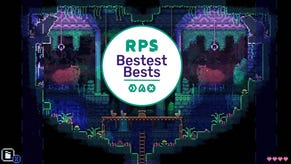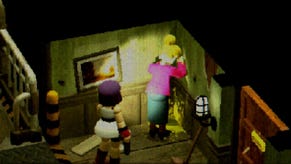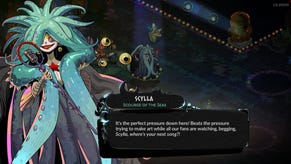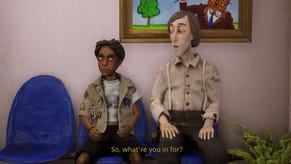Wot I Think - Din’s Curse: Demon War
Indie action RPG Din’s Curse is often referred to by Kieron as one of the games that got away- an acclaimed, interesting indie title that RPS never found the time to review. UNTIL TODAY. Following the release of the recent expansion, I’ve been spending quite a lot of time with this beauty, and am excited to present Wot I Think.
So, you’re a hero. A tall combine harvester of a man, with a unique knack for rolling forward and crushing and scything everything in your path, and you’re on a quest to rescue a lady, kill some monstrous boss monster and save a town. This tireless plot has been the set-up for a thousand fantasy videogames.
Now, imagine if you could fail at all this. Imagine if the lady could die, the monstrous boss monster could beat a retreat, and the town relying on you could, ultimately, be laid to waste. Imagine if everything mattered. That’s Din’s Curse.
The plot of Din’s Curse (revealed once you make your choice from a nice range of character classes) is that you’ve absolutely ruined the God Din’s faith in you, somehow. Perhaps you killed your family in a fit of fatherly pique. Perhaps you deleted Din’s favourite series off the digital box. It doesn’t matter and it’s never mentioned, because the plot of the game is that, as punishment, you have to travel the world under Din’s watchful gaze saving towns from monsters.
To anybody who’s played Diablo or Torchlight, things should get familiar at this point. The first town you’re spawned into has weapon vendors, apothecaries, merchants, a stash for your loot and plenty of incidental NPCs who don’t do anything of value. This is your home base, and from here you can venture down into the town’s dungeon and start beating the crap out of anything that moves, levelling up and gathering loot. While they’re all randomised, every town will have these facilities in common. They all act as small commercial bases sat on top of a dungeon like corks plugged into the top of active volcanos.
Something else Din’s Curse has in common with Diablo and Torchlight is a competence that’s immediately apparent from the first monster you kill with a leisurely thwack to the head. The animations, tempo and audio of the game are all excellently satisfying, and while its visuals are basic, they don’t get in the way of this being a rock-solid dungeon crawler.
To save each town you’ll need to perform any number of randomised quests, like hunting down the a particularly rude monster that’s mobilising all the other monsters, or smashing a portal, recovering a lost food shipment and so on, as well as finishing any number of side-quests. So far, so ordinary.
The twist of Din’s Curse, which is really more like a whip-fast roundhouse kick that takes your legs out from under you, is that these quests aren’t just static checkpoints like they are in Diablo, Torchlight or just about any dungeon crawler ever made. The quests in Din’s Curse are dynamic events that can, very often, be failed.
The first time I was bitten by this was in my very first town, on level 2 of the dungeon, trying to rescue some lost armour smith with the long term goal of stopping Deepfang, some demon who was starting an uprising of Hellhounds way down on level 6.
When I found the armour smith, she was getting the crap kicked out of her by a gang of orcs in a corner behind about two dozen barrels, and, to repurpose a line from Max Payne, the red was bleeding out of her health bar like it was a broken bottle of Tabasco. I sent my Demon Hunter crashing through the barrels, desperate to reach her in time, and arrived at the orcs as she was on death’s door. With a shield bash and an unholy strike I took away most of their punch, then hacked them to death in that sordid corner as fast as I could. The armour smith lived.
And then a message popped up saying that Deepfang’s uprising of Hellhounds was complete, and he was starting another one. Not only was floor 6 now full of Hellhounds, but if somebody didn’t deal with them soon, they’d attack the town.
Town attacks are the purest example of Din’s Curse dynamism. Screw up, or just get a run of bad luck, and monsters will come bursting out of the ground to butcher as many townspeople as they can. It turns out that those incidental NPCs have a purpose after all- in an attack, they provide much-needed fodder before the monsters attempt to slaughter vital townsfolk, like vendors and people with a head on their shoulders (read: quest-givers). One lovely little feature is that you can actually give arms and armour to each and every member of the town, so if you’re in a particularly miserable community that’s forced to repel monster attacks at every turn, you can try and equip the townsfolk. What then do you do when you’re one dungeon level away from the big bad that’s organising these attacks, and you get the message that the town is under attack? Do you press on, or fall back?
It’s a beautiful system because it’s just so emotive. Each town is a self-contained story. On average, each one might only take 25 minutes to save, but as well as the dungeon tileset and quests being different for each one, you also get to select the parameters of the next town you go to. Tougher monsters, more active NPCs and more active monsters are all options, and the result is that each town takes on a life of its own.
I don’t want to spoil anything, but I’ve encountered God-forsaken rain-swept disease-holes, perfectly lovely communities sat atop bottomless demon-holes, and one town where the confluence of four or five factors meant everybody was starving all the time, necessitating frequent trips back to the surface to give my people money like some bloodstained samaritan. That was a fun place to be.
Foremost in my mind, though, are the towns where I made the awesome mistake of cranking up the monster level away from “normal” and towards “hard”. Playing a game like Din’s Curse where you’ve got everything to lose is one thing. Playing it on a hard difficulty setting where you will, in all probability, go ahead and lose it makes for a fascinating experience.
It’s awesomely bleak, and a real test of will. Pushing deeper into the dungeon is as slow and tiring as tearing through its composite sod and stones with your bare hands, and all the while you’re getting messages in your chat ticker announcing your failure. He’s dead, she’s hungry, the bad guy is winning, and you’re down there with dirt packed tight under your fingernails and an imp gnawing at your ankle. Nobody said being a hero would be easy. But I’ll tell you something- when you finally do hit your stride, and you pick out some armour that gives you the right resistances, and you arrive at that enormous bad guy and- Jesus Christ- the game’s decided that he’s four times as big as any monster you’ve ever seen, and you go toe to toe with him and fell him with a final, desperate blow from your sword- that’s everything dungeon crawling can, and should be.
From a narrative point of view, it’s interesting for much the same reason that Minecraft was. Both it and Din’s Curse are games with little to nothing set in stone, plot-wise. There are no characters purpose-built for you to fall for, no set-pieces to take your breath away and no ending to provide closure, and yet the free-form design of the game provides something infinitely more alluring. You create your own stories, and explore your own landscape where anything can happen.
To put it another way, I played Torchlight for some ten hours and while I enjoyed myself, there’s part of me that considers those hours wasted. I was just clicking on monster after monster in an addict’s trance. Walking away from Din’s Curse, I’ve got all these lovely memories of heroism and failure, of tension and peace, of the time the town I was saving got ravaged of a thunderstorm of such apocalyptic intensity that it was actually safer to stay in the dungeon.
Or, to put it yet another way, I prefer Din’s Curse to Torchlight. Pop that in your pipe and smoke it.
That said, even if you've played both and disagree, Din's Curse does have one inarguable plus over Torchlight- it boasts full co-op multiplayer, something I didn't even touch but I can imagine would be great. One of you running back to defend the town while the other fights on alone? A whole gang of you pouring into the dungeon, desperate to interrupt the building of a machine before it's completed, boosting the strength of every monster in the dungeon? That sounds brilliant.
Developers Soldak Entertainment have, thankfully, released a demo so you can decide whether you want to take the $20 plunge for the base game. The trickier decision is whether you want the $10 Demon War expansion on top of that, and it’s tricky because I was playing with Demon War the entire time, so I don’t know precisely how much it adds.
In the words of the developers, what Demon War adds is more of what makes Din’s Curse unique, meaning greater variety in those randomised quests, NPCs that interact more with the world and more world modifiers. There’s a new class, new environments and some new monsters, too. On instinct, I’d say get it. You’re paying a total of $30 for dozens of hours of gaming, and you’re supporting another of those amazing indie titles that makes the PC great. Get it! Just get it. Get it all.















